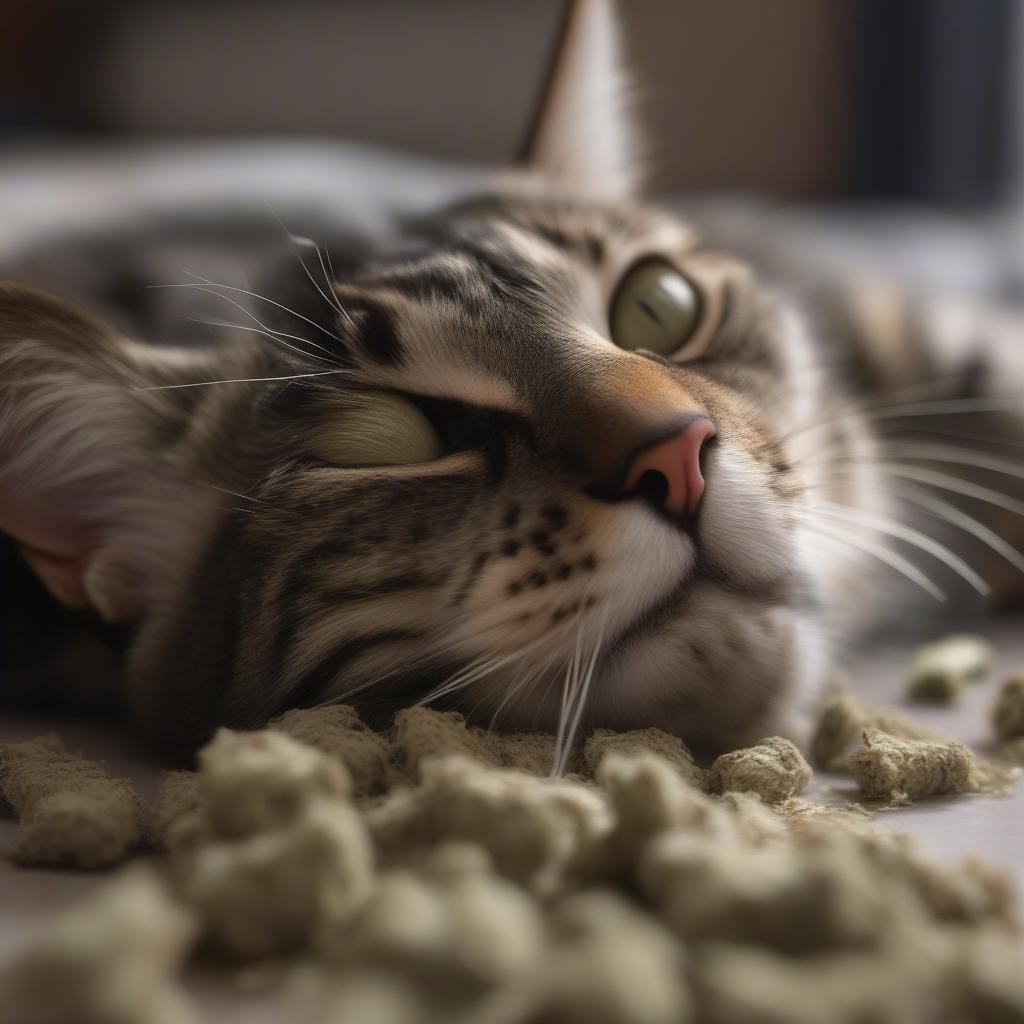Cats and catnip – a timeless duo. But Why Do Cats Love Catnip So Much? It’s a question that has intrigued cat owners and scientists alike for centuries. This seemingly simple plant has a profound effect on our feline friends, triggering a cascade of playful behaviors and euphoric reactions. From rolling around and purring excessively to batting at imaginary objects and vocalizing with abandon, catnip’s influence is undeniable. Let’s delve into the science behind this feline fascination and uncover the mysteries of this potent plant.
The Science Behind the Catnip Craze
Catnip, or Nepeta cataria, contains a chemical compound called nepetalactone. This volatile oil is what triggers the characteristic catnip response. Nepetalactone binds to receptors in the cat’s nasal passages, stimulating sensory neurons that connect to the olfactory bulb in the brain. This, in turn, affects areas of the brain associated with emotions and behaviors, essentially mimicking the effects of feline pheromones.
How Does Nepetalactone Work?
The nepetalactone molecule interacts with protein receptors in the cat’s nose. These receptors then stimulate sensory neurons, sending signals to the brain. This interaction triggers a response in the hypothalamus, the part of the brain responsible for regulating emotions, which leads to a range of behaviors associated with pleasure and excitement. The catnip response is not unlike a “high” for cats, though it’s entirely harmless and non-addictive.
 Cat Rolling in Catnip
Cat Rolling in Catnip
Not All Cats React to Catnip
Interestingly, the catnip response is hereditary. Not all cats are susceptible to its charms. The gene that controls the sensitivity to nepetalactone is dominant, meaning that if one parent carries the gene, there’s a high probability the offspring will inherit the catnip sensitivity. Approximately 50-75% of cats inherit this gene, leaving a significant portion of the feline population unaffected by catnip’s allure. Big cats, like lions and tigers, also carry this gene and can be affected by catnip, though their reaction might be less dramatic than their domestic counterparts.
Why Don’t All Cats React?
Kittens under six months old typically don’t react to catnip, as their olfactory systems are not yet fully developed. Furthermore, some cat breeds are less likely to carry the gene responsible for catnip sensitivity. For example, certain breeds like the Burmese are known to have a lower prevalence of the catnip response gene.
Beyond the Play: Other Uses of Catnip
Catnip is not just for playtime. It has other practical uses that can benefit your feline companion. For example, catnip can be used to encourage cats to use scratching posts, thereby saving your furniture from their claws. Sprinkling a bit of catnip on a new scratching post can make it instantly more appealing to your cat.
Catnip and Enrichment
Catnip can also be used as a form of environmental enrichment. Providing catnip toys can help alleviate boredom and reduce stress in indoor cats, contributing to their overall well-being. It can even be used to help cats adjust to new environments or situations.
 Cat Playing with Catnip Toy
Cat Playing with Catnip Toy
Conclusion: The Catnip Enigma
Why do cats love catnip so much? While the exact mechanisms are still being researched, the nepetalactone-induced euphoria offers a compelling explanation for this feline fascination. The playful behaviors triggered by catnip are not only entertaining to observe but also contribute to a cat’s overall well-being, making it a valuable addition to any cat lover’s arsenal. So, next time you see your cat rolling around in a pile of catnip, remember that it’s more than just a playful pastime – it’s a complex interaction between a plant and its feline admirer.
FAQ
- Is catnip safe for cats? Yes, catnip is generally safe for cats.
- How much catnip should I give my cat? A small amount is usually sufficient.
- How often can I give my cat catnip? Offer it a couple of times a week.
- Can kittens have catnip? They usually don’t react until they are around six months old.
- What if my cat doesn’t react to catnip? It’s perfectly normal; not all cats are genetically predisposed to respond.
- Are there alternatives to catnip? Yes, some cats respond to silvervine or valerian root.
- Can catnip be grown at home? Yes, it’s a relatively easy herb to cultivate.
For further assistance, please contact us at Email: contact@daiduongtranhba.com, or visit our office at Michigan Ave, Suite 3100, Chicago, IL 60611, USA. We have a 24/7 customer service team available to help.

